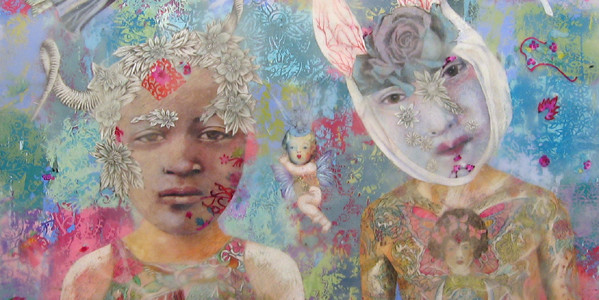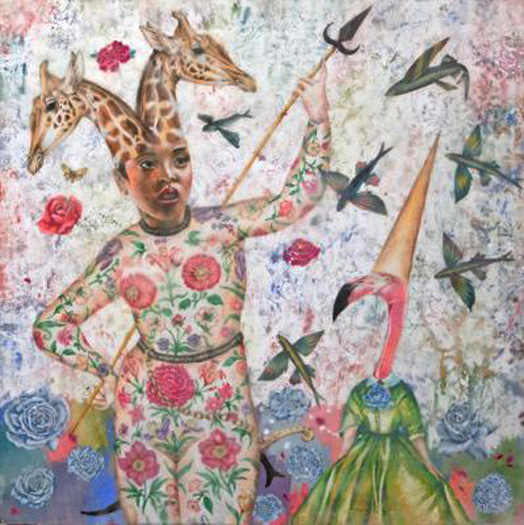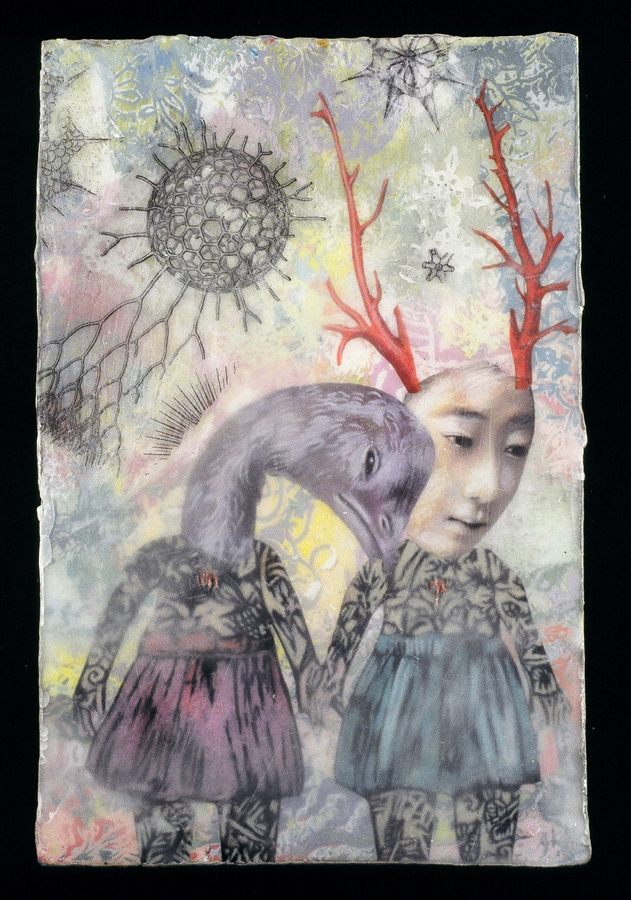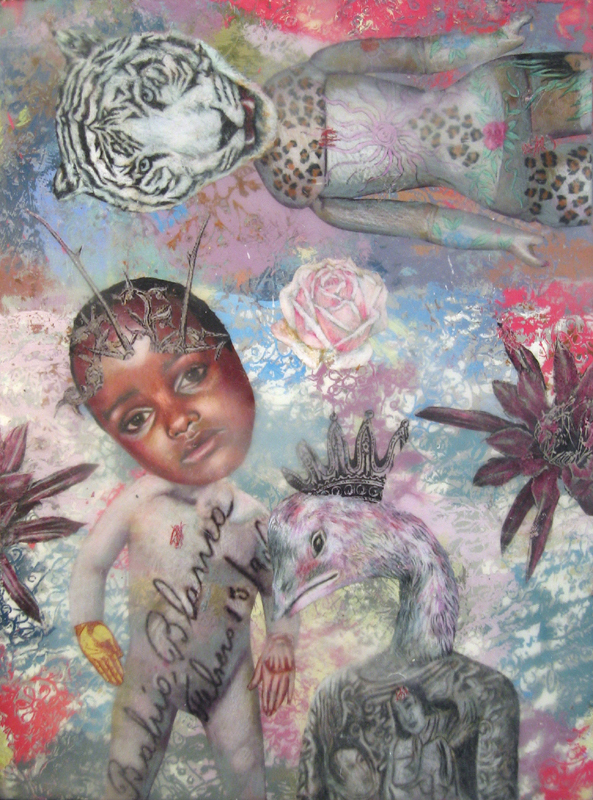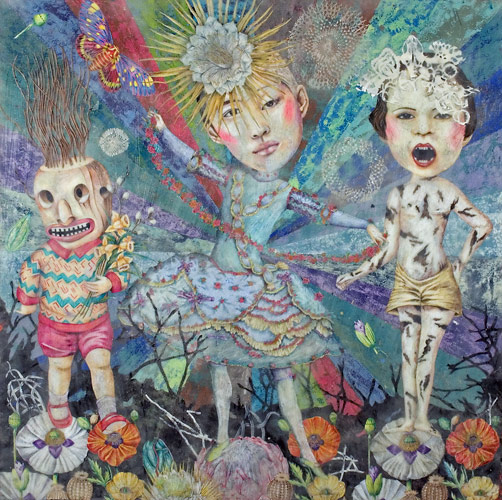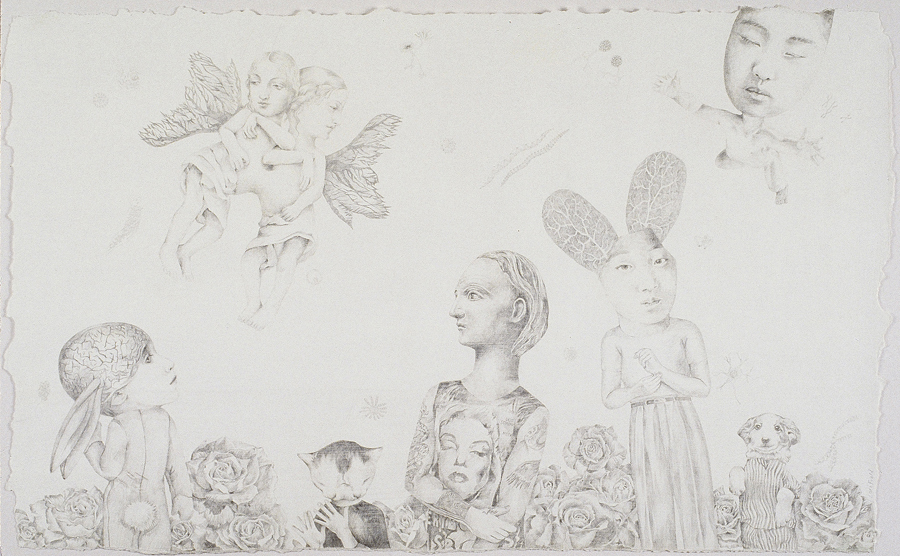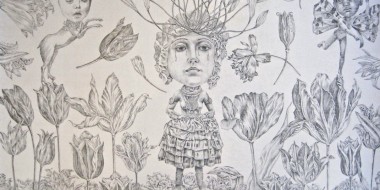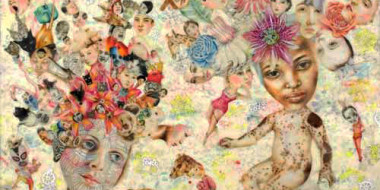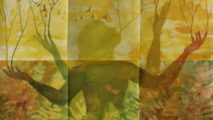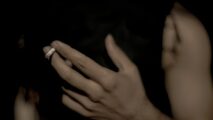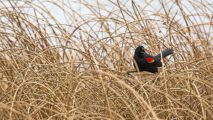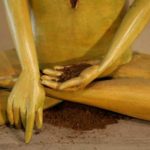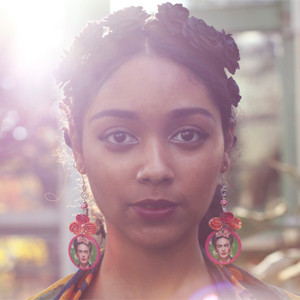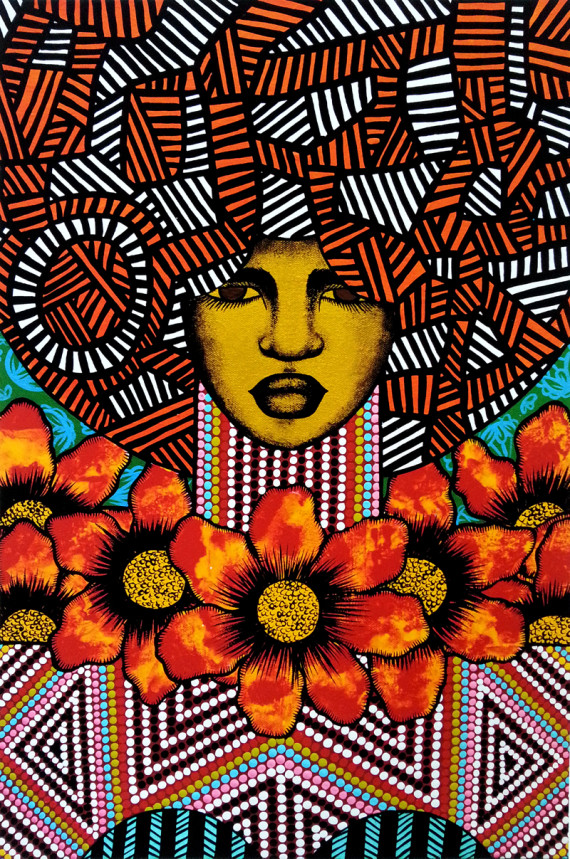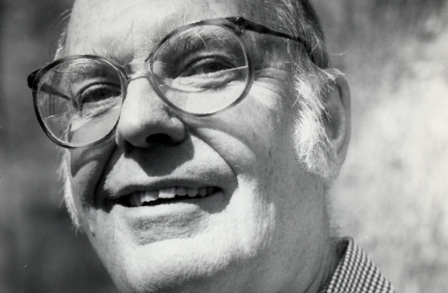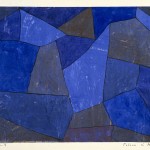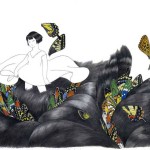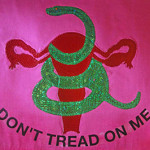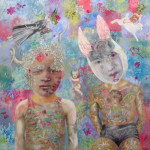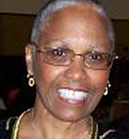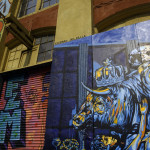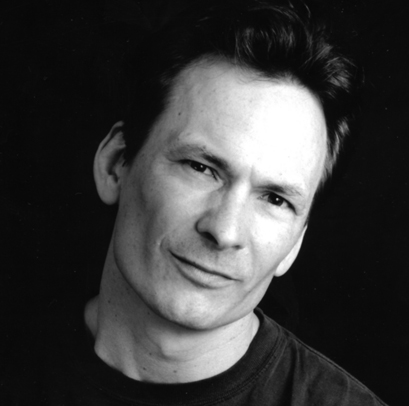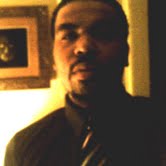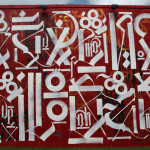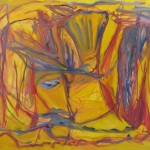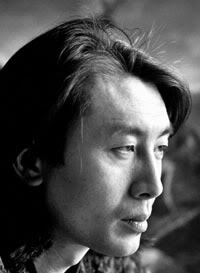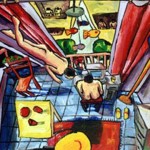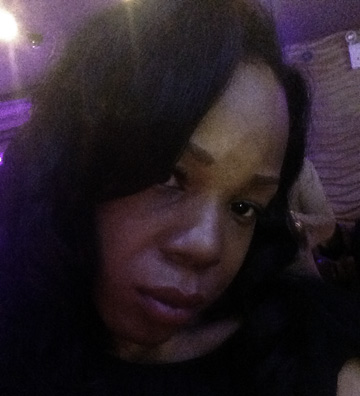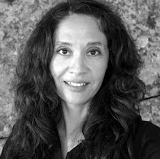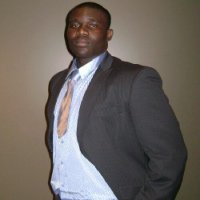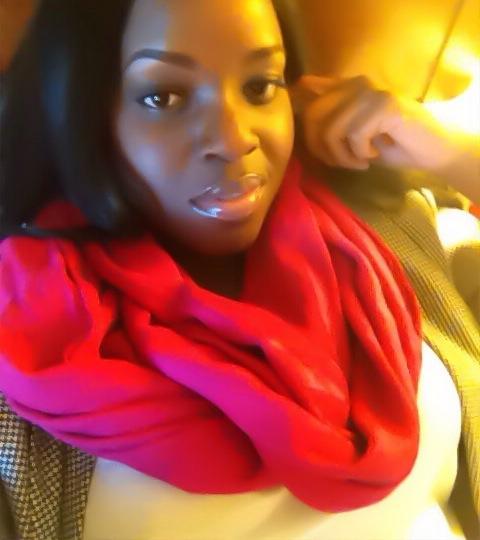In essence, we are all the ‘other’, and when we recognize this the world opens up.–Lori Field
Pamela Hughes: Your works are often magical combinations of human and animals for example; some of my faves: Little Babji, Pinky and the Brain, or Babes in the Woods that goes back from when you had a show at Bloomfield college in 2003. How did these beings come to inhabit your mind and art?
LF: By the way, in Pinky and The Brain, do you know who is The brain and who is Pinky?
PH: No, who is who?
LF: The flamingo is the Brain and the other one is Pinky. It would stand to reason that the flamingo would be Pinky. I like to put ironic twists in my titles. Little Jokes. To have fun with them. I appreciate puns, plays on words For example, one title is, “You’re No Bunny Until Somebody loves You.” Sometimes what inspires me to create a piece is a having a title in mind that I like. I did this show in Nashville called “I am Curious Yellow,” which is an old porn movie from the 70s–which I’ve never seen–but I wanted to embrace this color and create a whole show around it because of the title. Sometimes I have titles that I can’t wait to create the art for. Like The Teflon Don. And it will not be image of John Gotti. I like the tongue in cheek thing. Though every surface indication about it will say otherwise, there will be a connection, but not an obvious one.
PH: So the is subtext is the connection. It could be ironic, comic or mythic—and is often playful. Playful is always good.
LF: I have a lot of fun. This is my play. It is also my spirituality. The anthropomorphism is like Native American myth making. I am very influenced by mythologies from all over the world and different time periods. A lot of them have animal imagery or gods and goddesses. I first started getting interested in the animals of the Chinese zodiac. Then I started to read about Native American myths. I was drawn to totem animals—animals as symbols. I was very drawn to animals and they rapidly became a way to interpret human emotions. They became symbolically emotive personifications of human traits–a rabbit can representative of fearfulness, tigers of fierceness or protectiveness. Pigs are an interpretation of indulgence or hedonism. However, animals have different range of emotions that they can express, not just one. The combination of humans and animals are archetypes–they become like my own little set of gods and goddess.
PH: A sort of mythological cast of characters.
LR: That’s a good way of putting it. I wanted to say one more thing about my use of animal imagery very often I use animals that don’t make a sound make sounds like rabbits, giraffes, deer. I either use an animal that makes a big sound–like a tiger–or animal that makes no sound. I like the hyper-awareness of listening. Rabbits have this giant hyper awareness with their ears. Of course all animals can hear better then we can. I love to use animals that make no sound or cry out. They have this presence–a power that comes from listening and not speaking.
PH: I’ve noticed that the subjects of your art pieces are very diverse kinds of people. How or why does multiculturalism play into your vision as an artist?
LF: When I first started making these pieces 15 years ago I only seemed to include Asian faces. I think it was a past life. I have always had an affinity for 1920’s China, especially the Shanghai Girls posters from that era. So I started off using those faces in my work. Then, I expanded and started to include faces from other cultures, Africa, South America, and faces from the past, 1920’s flapper portraits or 1920’s. French pornographic cabinet cards in particular. I did this because I started feeling it was too much of one kind of face. I wanted the work to feel more universal–to reflect the human condition. I began looking for anything outside of mainstream WASP sensibilities in an effort to exaggerate the ‘other’ characteristics in the figures.
PH: Speaking of the other, after seeing your show, Becoming Animal, at Westminster Hall at Bloomfield College back in 2003, I started to have my creative writing students choose one of your art pieces and write a stream of consciousness poem about it. At first the students had a general response to your work–that it was weird, or disturbing. I interpreted this that they were afraid of what they didn’t know about the other–both outside and within themselves. After they wrote their poems—made a connection and got an understanding of the other figure–and I like to think about themselves–there was almost with a kind collective of sigh of relief. Can you touch on this frightening other?
LF: I think the initial reaction of your students is a universal one when confronted with the strange, the different or the outcast. People recognize something of themselves in a depiction of the other and they become either subconsciously or consciously repelled. This is because on some level they know what it is like to be ridiculed, singled out as different, shunned or treated with prejudice and they don’t want to deal with that. The success of Reality TV in my opinion is successful because of this. The people we are watching are laughable, ridiculous, and strange–we, the viewers can feel safe; so we are okay. My work elicits the same responses at first. Those creatures are odd, people think: I don’t want to recognize myself in them. I want to separate myself from their predicament.
Upon closer inspection or intimacy with their subject—the writing of the poem about it–a realization and a self-recognition probably took place. A curious emotional bond might have occurred, and what was alien at first becomes familiar, and accepted. The same way a person can be prejudiced against a group of people, but when they get to know someone individually from that group, their attitude towards them changes. A person who treats gay people differently, less than or as the other, might change their approach if they find out a treasured member of their family turns out to be gay.
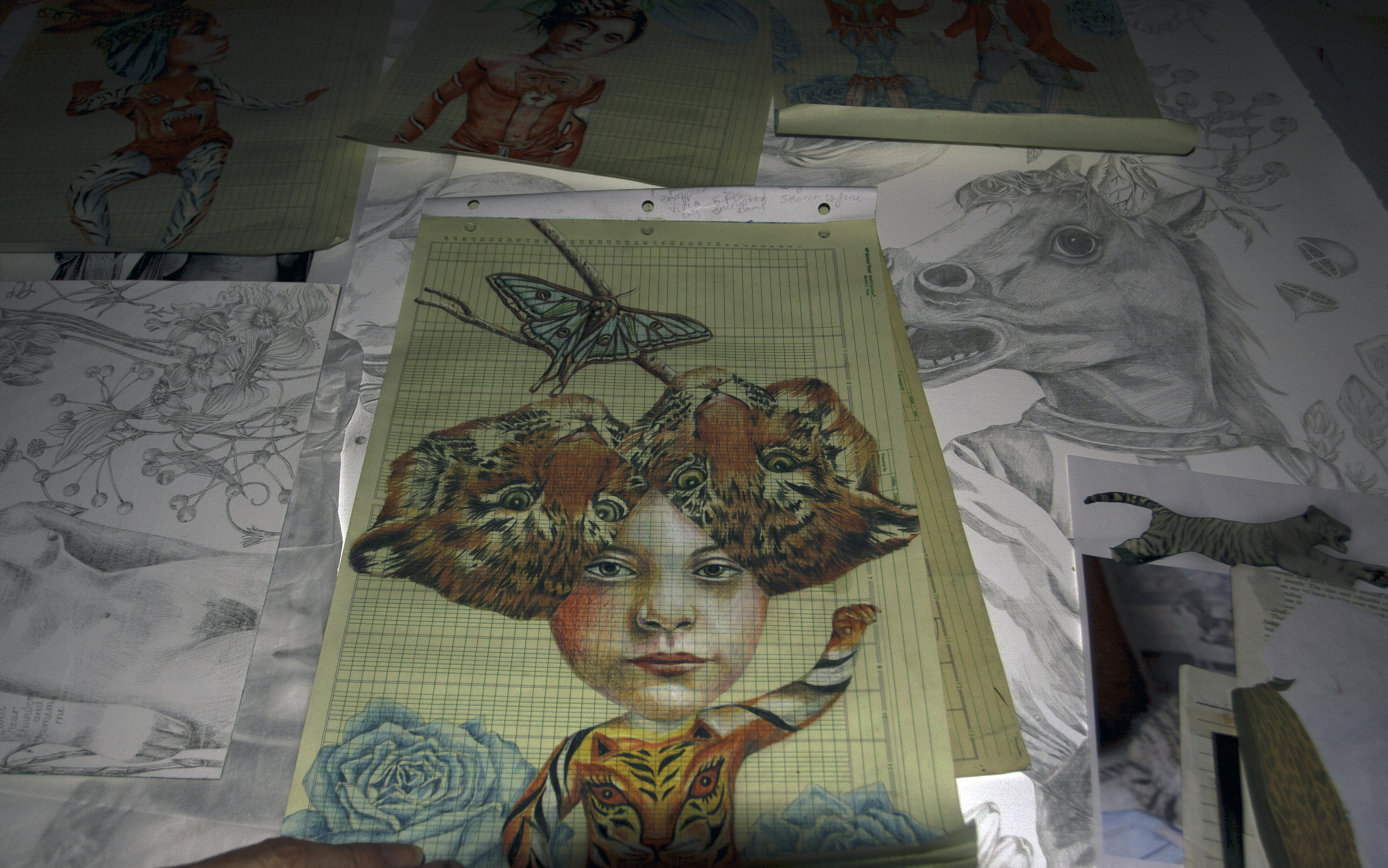
New Work at Lori’s Studio
PH: That’s a profound recognition. One of my students who wrote one of the stream of consciousness poems said he met you.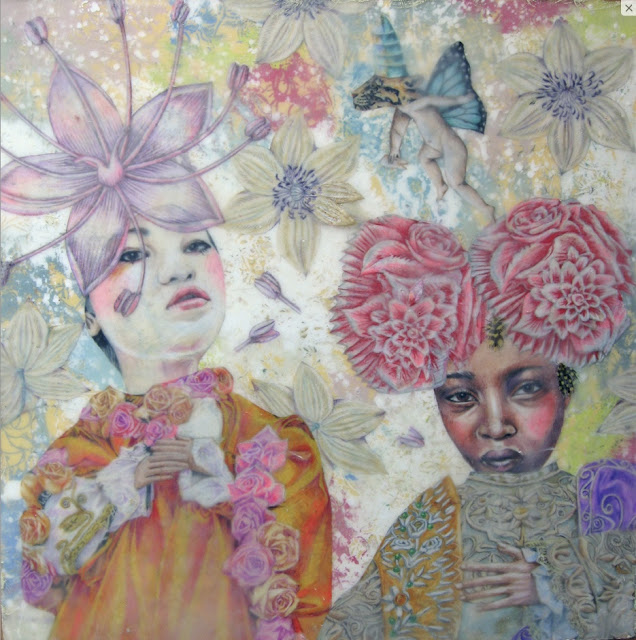
LF: He worked at Mail Boxes Etc! I had been going there literally for years I send my artwork through there. I do my Xeroxing there. He was not unfriendly but was very business-like. He didn’t know what I did. And then one day when I was making copies he said to me, “Mrs. Field I just wanted you to know I didn’t know who you were before, but I saw all your work. I take this class at Bloomfield College and saw all your work!” He was pretty much gushing and prior to that he was removed and business like as you can be. We had this nice conversation. I already knew what you were doing with your students.
PH: A connection through art. Your work must have really resonated with him.
LF: Which pieces were you showing the students–the older work?
PH: Both the older, and more recently, the newer work from your portfolios As I said, a lot of times students think new things are strange at first–especially if they are not into the arts or literature. They tend to think one dimensionally, but after they explore a work of art—let’s say a poem—or in this case one of your pieces–they start to build some layers of meaning, to open up.
LF: That’s the other thing about of my work. I like the idea of pulling someone in with something beautiful and then clobbering them over the head. To try to force that opening. The beauty in the work needs to be seductive. Especially for the people that haven’t been exposed to art that much. On one level, they are drawn in, but will still say things like: “that is really weird! I don’t know I can deal with that!” That is my intention. I want them to be shocked by it. But not shock for just for shock value alone, I want them to think the art is beautiful and be touched by it. Sometimes the things that are the most beautiful are the things that are most strange You don’t get to say what is beautiful by these hallmark card ideas or by top model beauty standards. Sometimes beauty is something very very different. To me it is like opening your eyes to what beauty really is. My mother is very conservative. The other day I posted one of my images that had a little bit less strangeness to it. I did it for a show in Berlin where the focus was about Hollywood movie stars. I put Merle Oberon’s face in it surrounded by all these flowers. And my mother called me up all excited. “Oh my god,” she said “this one is so beautiful! It is so different then the other ones where you have where all this strange things growing out of their heads. I said “yes, mom that is nice, but did you notice that she had thread sewn all over her face–that she has tattoos made of thread? She was like “I didn’t notice that because it was so beautiful!”
PH: Art should shake us from complacency. Now more than ever, it seems like many people just want to absorb information from TV and computer, smart phones– just sit around doing this for long periods of time, which is really doing nothing.
LF: Art can shift us from our narrow parameters. Again, we are learning about the other, the intimate stranger. In speaking to the your earlier question about the other, I really want to address the idea that people in society are being marginalized for their differences. It’s absolutely diabolical how groups are being targeted for their otherness, whether they be minorities, or an ethnicity, or gay. Just people who are different in some from what is way not “sanctioned” by our society. It seems like we’ve gone into this retroactive phase, a reactionary phase, where people are being treated worse again. We’ve made some strides, but now we’ve taken so many steps back. It is alarming I really want the want the figures that I am putting out there to address this otherness. They are exaggerated for this reason. I want people to identify with these figures–to be weirded out and then to recognize themselves. Because we are all the other.
PH: That’s where I get a sense of the so called quantum consciousness about your work–not only does it embrace diverse people but also animals and the connection between all things. Can you speak to that?
I have an absolute reverential feeling for animals. They are here for significant and profound reasons. I did one really large piece called “Love and Fear, Love or Fear” that was done specifically because I had been working on a solo in New York and I was working so hard that weekend when one of my beloved animals become ill and I figured, I’ll take her to the Vet on Monday. I was too fearful that I wouldn’t to get things done on time. It was a holiday weekend so it ended up being four days instead of two. When I dropped her off, I thought: we dodged the bullet, but she died overnight. I considered her to be my equal companion, and I chose fear over love. I still could cry when I talk about it now. You can choose love or fear, but you are always better off choosing love. That’s what that question invokes in me. Yeah, they are right up there with us, animals. Sometimes I think they are superior in a lot of ways.
PH: I have to agree. Animals don’t kill for the pleasure of killing. Sometimes cats will play with small creatures, but generally animals only kill what they need to eat. Animals don’t create the destruction to the planet we humans are creating. But getting back to the creation of your art, Jung said “the creation of something new is not accomplished by the intellect, but the play of instinct acting from inner necessity the creative mind plays with it loves.” Your art has a Jungian feel to it–do you ever dream of your art pieces?
LF: I do not, but when I’m in the shower, everything comes to me. I’m going to invent a writing pad to take it into the shower [Laughs]. Because I have the most amazing ideas there. I’ve learned that I need a paper to write it on. I’m dripping on as I write it. [Laughs] It is kind of like when people have a dream journal beside their beds and they need to jump up to write down their dreams before they are lost. There is some kind of primal thing about water that does this for me. It’s probably because of the spirituality of water. I have an affinity for it. I was raised in Florida . The Gulf of Mexico is precious to me. I don’t dream about my work but, I have day dreams about my work in the water.
PH: So what other things inspire you? Who are your artistic influences?
LF: Oh that’s easy. My top three are Hans Holbein, Kiki Smith and Henry Darger. Darger is probably on top of the list. He was an outsider artist who didn’t even know he was an outsider artist. He was a marginalized person living as a janitor his whole life in Chicago and when he passed away his landlord went into his apartment and found an amazing treasure trove of the work he had been doing his whole life. He also wrote a book this about this big [holds hands about a foot apart] about an entire mythic world It was called something like The Vivian Girls Vs. the Glandeco-Angelinians. He was quite crazy, but not in an aggressive way. He had never had any training, but he was compelled to make these impressive pieces kind of like scrolls. He would take children’s coloring books and use the figures to create the world that he wrote in the book He is my major influence and speaks to me on deep level.. See that piece over there with the sheep? [Points to a studio wall behind me] It’s a piece of a little girl figure who is wearing a dress and has this tiny penis peaking out. Darger did this a lot with these girls in baby doll dresses. They would often have ram horns and tiny penises. 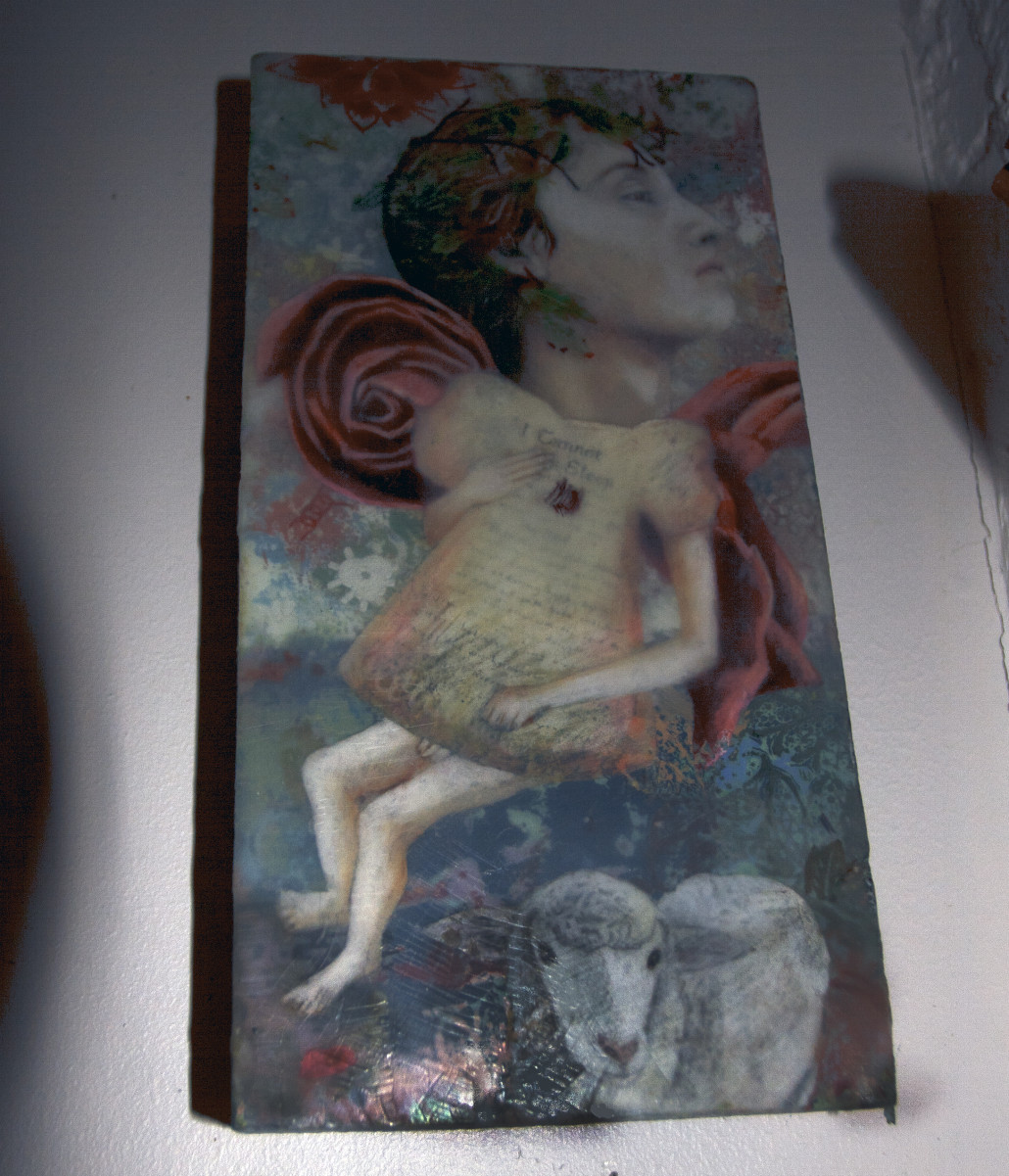
PH: Hermaphrodites?
LF: Yes, he did this very hermaphroditic thing. The pieces are very strange. They seem to tap into the collective unconscious. Switching to Holbein, he did portraits that were so beautifully detailed that almost hyper real. I love history and that he did portraits of historical figures and captured them so intensely you felt you were in the room with them just blows my mind. I could stare at his work all day. I left off a host of other influences. And then Kiki Smith is a contemporary artist, who does print making, sculpture, does a lot of mythological pieces related to the body and feminism. She is just incredible and extremely prolific.
PH: Any suggestions for teens or young adults that want to become artists?
LF: Grow a thick skin! Do what you love and the rest will follow. Never give up. It is very hard to be an artist of any ilk: writer, visual artist, actor. There is tremendous competition. People envy the connection that artist’s have with their inner life. The working world cuts you off so much from that, that it’s appealing to see that artists still have that. That could manifest in a lot ways. Sometimes people outside of the art world will put artist’s down. I think they want them to feel-less-than, because they are not able to get in touch with that. They are not even speaking the same language anymore. I would tell a young person to be persistent. Also know when to let your art evolve. Find people that in your corner that understand what you are trying to do. If it is really your calling and you stick with it, you will find the way. Another thing, don’t copy other people. That’s important. A friend of mine, who is an artist, was devastated when she took another artist under her wing and that person started doing work that looked exactly like hers. And she is also showing her work. That is a problem. So it is the worst thing you can do, not only for the other person you are copying, but for you. You can lift a little inspiration here and there, but find your own voice or vision.
PH: I love that art can help a person find their own voice or vision. We touched on this indirectly, but can you speak to arts as catalyst for positive change in the world?
LF: Oh yes! A lot of my work inspired from stories I hear about in the news and the desire to elicit change. I see a lot of navel gazing in the art world these days and less work about political situations or about affecting social change. Every once in a while you will see it and there needs to be more of that actually
PH: Is there a single message or theme that you would like your viewers of your artwork to get?
LF: My work is always about vulnerability in some way. It’s about so many other things, but a reoccurring thread, to distill it down to one word, would be vulnerability. It is the human condition. We are all out there and you can make a fuss or put on whatever protective mask you want to wear, but if you scratch the surface that fact is it always there. So people wear their power suits like armor. I’m going doing a series of jewelry pieces that will become part of an art installation called “The Attack of the Killer Business Men.” It will have anthropomorphic figures and be about power versus vulnerability. Who is really powerful? In our society, we have our mythic characters. We have our Wall Street bankers. That is our contemporary mythology. It’s real And at the same time it’s not real. When you take away all the trappings–the facades–we are all equivalent.
PH: I guess you could say that the mythology of your art—like the power of all art—can be a kind of counter balance, a sort of equalizer. It does seem to have an effect on people.
LF: The symbolism of my figures works on the subconscious level. I was doing this show at college gallery in New Jersey. It was Fairleigh Dickinson. The name of the show was Other World. The gallery was a walk through space. People weren’t necessarily seeking art when they would pass through. A few weeks later, I got an email from a woman who worked at the school. She was someone who never looked at or liked art. But as she walked through the gallery to get to work, she fell in love with this piece, a little animal anthropomorphic drawing with a piece of animal in rabbit in with wings. I actually have the collage here if you want to photograph it. She was so taken by it that she tracked me down and bought the piece. She said never in a million years would I think that something like that would speak to me, but it was screaming out to me as I walked past. That is the effect that I would love my art to have on people, to touched by—even if they are not “art” people–and don’t even understand why.
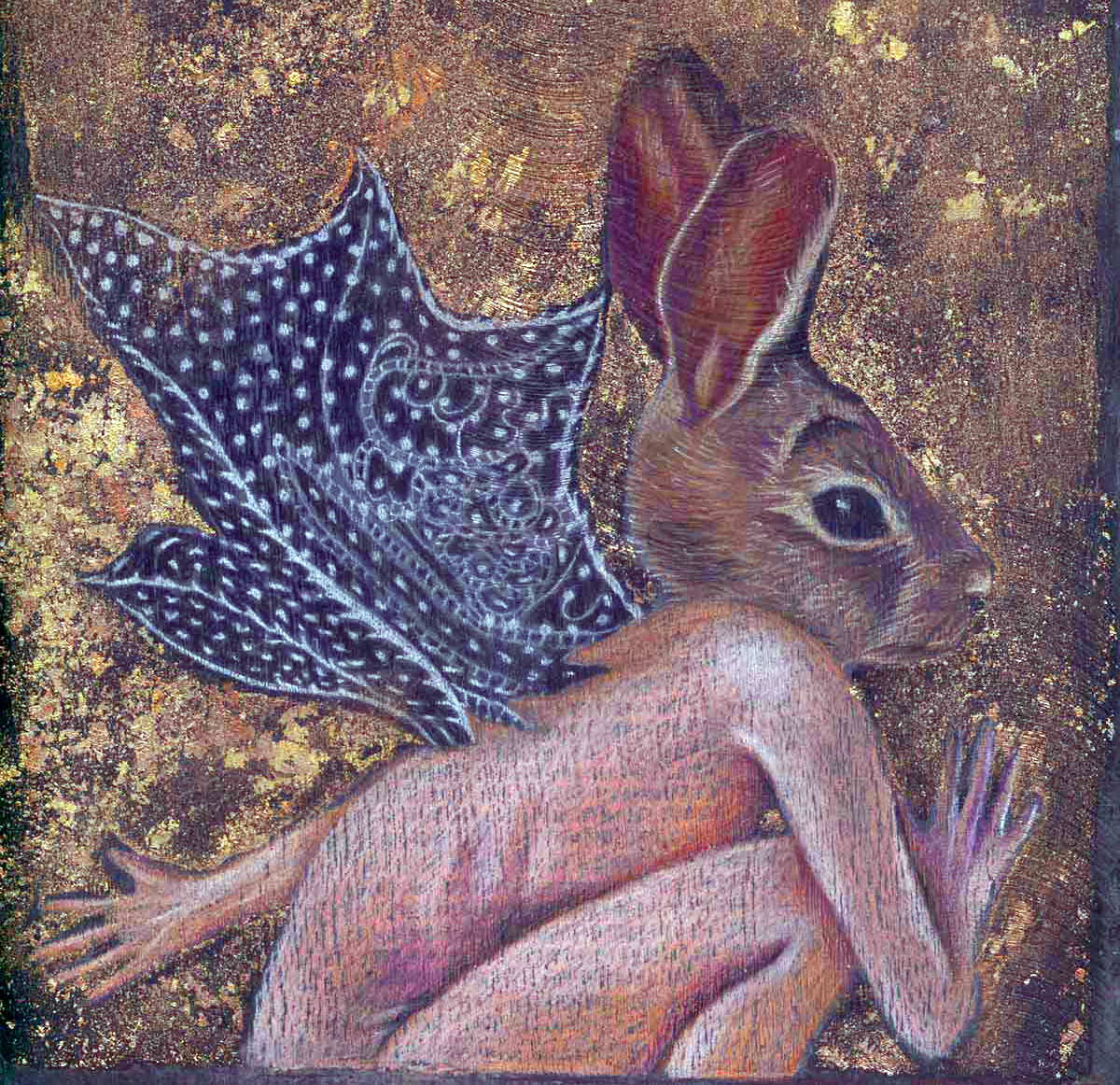
Flora
PH: And that was Flora?
LF: Yes.

Lori Field, Girlfriends with Flora figure
PH: I’ve written about Flora. I’ll have to send you that poem.
LF: Here, let me bring it over so you can see it. [Goes to get the framed collage] One of the original ones was called Flora and Fauna.
PH: I saw another of the originals at Westminister Gallery. Flora was on slate. I took a photo of it on the wall and then wrote a poem about it.
LF: Was it the big one or the smaller? Because I did both.
PH: It was the little one.
LF: That’s the one the woman bought!
PH: That’s pretty amazing. It’s a synchronicity–Jungian. That you’re telling me about a woman who became so connected to Flora that she had to buy it–and that it was the same piece that also captivated me and has become a part of my own art.
PH: I noticed that in this Flora, the deer has… [pauses]
LF: . — A female body
PH: And also pubic hair.
LF: The symbolic bush. [Both laughing]
PH: I have a poem called Vote Bush. The title appears to be asking people to vote for George Bush, but it’s really asking people to vote for femininity, to honor the female body, to bring life into the world instead of destruction, war. It’s kind of funny. A poet named Joan Larkin said that when she read it she couldn’t stop laughing. Also, I guess we should vote that back in instead of all the shaving.
LF: I think the young women are starting to revolt. My daughter actually did an art project at Pratt–I guess you could say—in protest of that. I always think, what if we have an economic collapse? What if you can’t get money from the ATM machine? Are you really going to spend your last few dollars so you can go out to buy a kit so you can get a Brazilian? [Both laughing.]
PH: Your funny! I would love to see your daughter’s art work on that theme for a woman’s issue I’m thinking about doing for the next issue of Narrative Northeast. But since we are on topics womanly, your art also seems art seems grounded in some kind of feminine mythos. How does that or female empowerment play into your creations?
LF: It’s very interesting. A few years ago I had an open studio here. There was only one guy in the room. He was looking around while the women in the room were talking. He looked at one of my pieces and looked back at me, and then he said, “You don’t have any male figures in your work.” At first that came as a surprise to me, then I realized that it was true. If they are in my work, they are effeminate, boys or non-specific in gender. It wasn’t something that was intentional. But ever since he brought that up, I’ve embraced it. I don’t think of myself as a feminist but of course I am. I have two daughters. I’m conscious of the things feminists are conscious of. I am female after all, and these things affect me as well. It’s not part of my conscious thought process when I am creating my art, but if it does speak to people on that level than I am very happy. The figures are a kind of female shaman figures. They are very powerful in their own way, but they can also acknowledge their own vulnerability. This is part of their strength. The same goes for all women.
